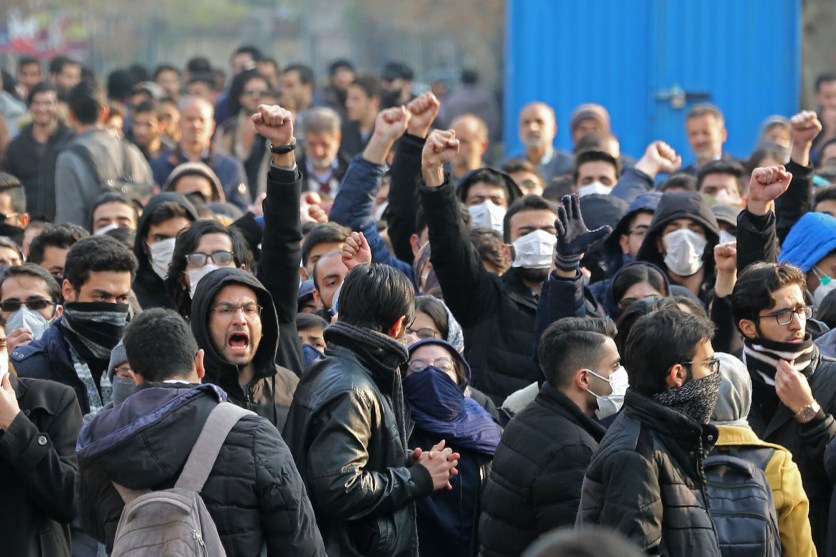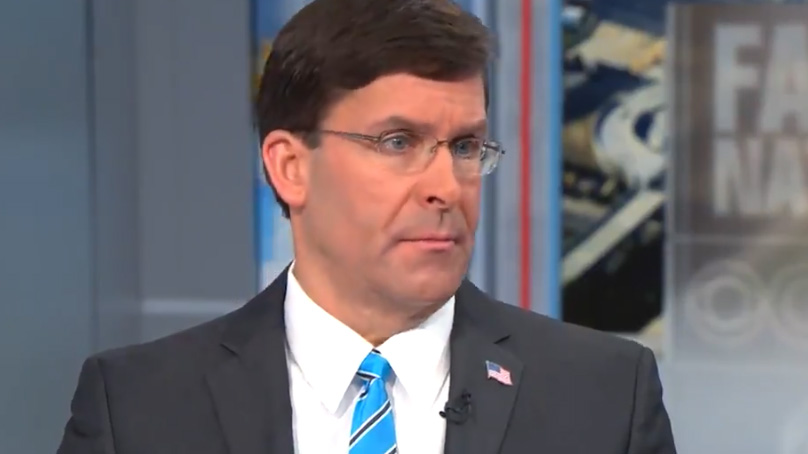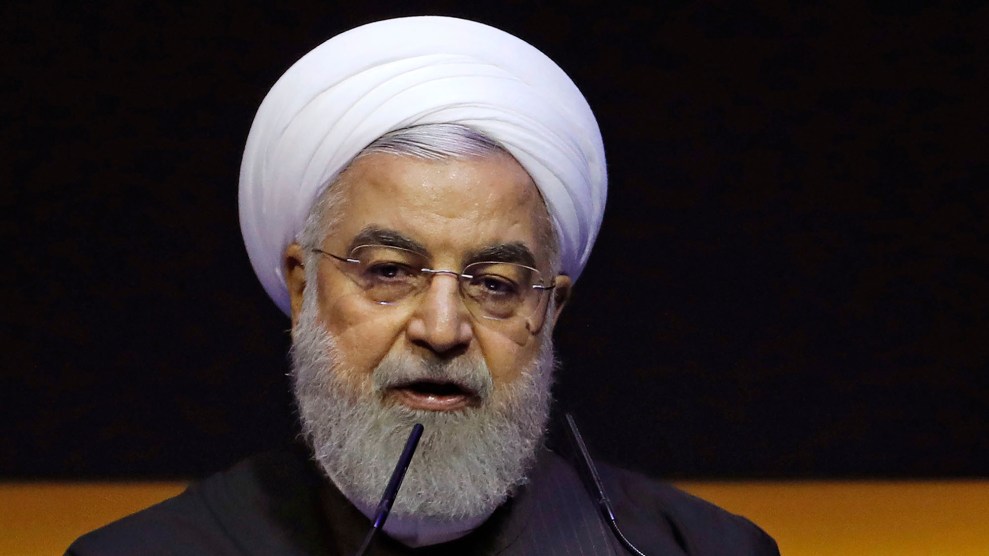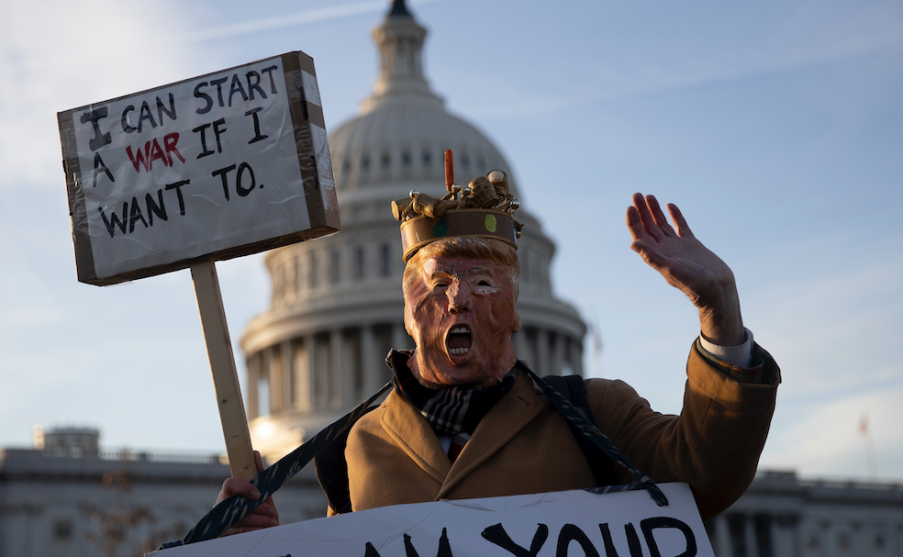
Iranian students gather for a demonstration over the downing of a Ukrainian airliner at Tehran University on January 14, 2020.Atta Kenare/AFP via Getty Images
When Iran’s military admitted on Saturday that it had mistakenly shot down a civilian airliner, Ukraine Airlines Flight 752—killing all 176 of its mainly Iranian passengers and crew—Iranians started taking to the streets in shock, sadness, and outrage that, for many, at least temporarily overshadowed their anger toward the United States after it assassinated top Quds Force Gen. Qassem Soleimani in an airstrike earlier this month.
Now in their sixth day of protests, demonstrators are condemning the killings and criticizing the government behind them, with some demanding the resignation of Supreme Leader Ali Khamenei. Videos on social media show Iranians burning images of Khamenei and chanting slogans like, “They lied when they told us it was America—our enemy is right here.” Eyewitnesses claim that government militias are firing live ammunition at protestors.
These latest protests aren’t the first time Iranians have taken to the streets in recent months. The country’s domestic politics have been volatile in recent years, particularly under President Donald Trump’s “maximum pressure” regime of military force and extreme sanctions. In November, tens of thousands of Iranians staged spontaneous rallies after a surprise hike in gas prices, furious with a government often seen as corrupt, incompetent, and invested in Middle East proxy wars at the expense of its citizens’ welfare.
The uprisings are the results of an “accumulation of crises” in Iran, says Peyman Jafari, a researcher and historian at Princeton University’s Center for Iran Persian Gulf Studies. Yet major political change, he says, won’t come until students, workers, and middle-class professionals fed up with economic struggle and political repression unify their protests and demands.
To understand more about the motivations driving the rallies, and where they might lead, Mother Jones spoke at length to Jafari, who studies Iran’s history, social movements, and politics.
Could you give some background on the massive Iranian protests in November and December, and connect them to what’s going on now?
The demonstrations in November were triggered by a socioeconomic issue: the rising of the fuel price. The middle class had sympathy with these protests, but really didn’t join. This time around, we had the crash of the airplane, of course. And I think it brought two crises of the Islamic Republic together: what I call the crisis of legitimacy, because of the lying—it was not only the crash of the airplane, but also that the government didn’t tell the truth for three days, that ignited that wider demand of transparency, of democracy.
The other crisis linked to this event is the crisis of competency: these huge grievances about the government not being able to protect its citizens, to provide public services, security, and so on. Shooting down the airplane brought that to the fore—doing this, by mistake, cost 170-plus people their lives. So this was a huge issue. The constituency this time around is more middle class, more students.
More generally, there has been an accumulation of crises in Iran. The crises of competency, of legitimacy, the socioeconomic crisis. The current establishment has moved away from promises of social justice and equality, and has introduced more neoliberal policies since the 1990s. Now we see flexibility in the labor market, lots of precarious jobs, subcontracting. Wages are basically low. Lots of strikes we see happening are about unpaid wages or low wages. And then we have an environmental crisis, particularly in southern Iran, with drought and so on.
All these crises are converging, and the demands are affecting both the lower classes and the middle classes, which have seen a huge drop in their income. So there is a chance of these [different protests] converging, but this will not happen automatically. What you need is actually people, organizations, trade unions, NGOs, activist networks that can make these connections, that can formulate these kinds of demands.
Was there any overlap between Iranians who protested the Soleimani assassination and the people who demonstrated against the airplane attack or the gas price hike?
Some people have been commenting that these protests mean Iranians were not united by the Soleimani assassination. But it’s important to stress that Iran is a large country, and it’s not monolithic. These can be existing groups, parallel to each other. Even more so, the same person can be against the assassination of Soleimani and be against corruption and authoritarianism in Iran. I think the assassination of Soleimani crystallized a nationalism that is still very strong in Iran. Those things can really exist simultaneously.
There’s a lot of Iran-related disinformation on social media, especially Twitter, Telegram, and Instagram, where accounts with few followers sometimes share unverifiable info about demonstrations and crackdowns. How concerned should we be about disinformation as we try to make sense of these protests?
Disinformation is being sent out by the Iranian government and by the US government, which also organizes a disinfo campaign. You have these bots organized by very small but rich outside groups, such as the MKO [an armed, US–backed opposition group] and royalists, that create an echo chamber.
Trump was bragging about his tweet in Persian being the most retweeted Persian-language tweet. But much of that retweeting happens by these bots, and through these online activist cyber armies like the MKO. Their activism, now, is basically tweeting. They have these halls of aging activists sitting behind computers and sending out tweets all day long. [On Saturday, Trump issued his first Farsi tweet: “To the brave and suffering people of Iran: from the beginning of my presidency, I have stood with you, and my government will continue to stand with you. We are following your protests closely. Your courage is inspirational.”]
That’s definitely part of reality, but not the entire reality. There are other Iranians on Twitter, on social media, both outside of and within Iran, who are very active and taking positions. One should not dismiss those as not genuine. There is lots of genuine activity.
Are distortions on social media a major concern within Iran, especially for protestors?
In Iran, no. In Iran, people, by this time, know where everything’s happening. When Trump tweeted in Persian, a lot of Iranians’ reaction was just, “Shut up. You have instituted a travel ban. You have targeted our cultural sites. You have been sanctioning us.” People are aware of that.
There’s of course the problem of the so-called fake news: which demonstrations are real, what’s speculation about shooting on demonstrations. But that problem is really general. My sense is that most people are aware and know how to go around that.
In the US, there’s been a lot of coverage of the video of protesting students at Shahid Beheshti University, a prominent Iranian university, being careful not to walk on US and Israeli flags that have been painted on the ground for propaganda purposes. What do you think that clip tells us?
People made a big deal of it, but it’s not new. It’s happened in the last few years, but it’s become more politicized now. My interpretation is that students were doing this because they basically wanted to give the middle finger to Iranian authorities, because this [trampling the flags] is imposed on them.
But this does not mean that they are blind to Israel or America’s foreign policies. Many of those students are very critical of what is happening in Israel or what is happening with the economic sanctions. Actually, that university is sanctioned by the US! Its students haven’t been able to travel to the US to study. But I think the point is that they are refusing to do it precisely because the government and local authorities are forcing them to.
What about the tearing up or burning of photographs of Supreme Leader Khamenei, which happened during the November protests and again this week?
We also saw it in the 2009 protests. There has been a growing critique of the Supreme Leader in wider sections of society, because he’s ultimately the person responsible for what is happening. He takes credit for the good things, but doesn’t want to be held responsible for what’s going on now. This is a sign of people demanding accountability from the leading figure in the government. But, again, Iran is a country of 80-plus million. This has been done increasingly often, but not by everybody, of course.
On Twitter and elsewhere, Trump and the White House have been trying to involve themselves in these protests. What consequences could that have for protestors in Iran?
I think it has actually been totally counterproductive. First of all, it is strengthening the authoritarian nature of the Islamic Republic, because it gives more power to the Revolutionary Guards. It galvanizes and heartens the supporters of the Islamic Republic, because they feel threatened and think everybody opposing them is an agent of the United States. After the assassination of Soleimani, we saw the Revolutionary Guards recruit directly from the ranks of young people to draw in new blood. When we see the reemergence of protests, they will be confronted with increased, militarized repression by the government of Iran.
The second thing is, US economic sanctions cut off the oxygen for civil society in Iran. I think strikes, which can really affect the government, are much more effective than demonstrations. But many people will be more tempted to sit on the fence and not join the movement, because they are afraid of the [economic] consequences.
So no, I don’t think Trump should take credit for what is happening. Even if there were to be a regime collapse because of this “maximum pressure,” the outcome of that will not necessarily be democratic under current conditions. It could mean more chaos, civil war, the disintegration of Iranian civil society. Even if the economic sanctions do [to Iran] what they did to Iraq in the 90s, disintegrating the social fabric, people will fall back on family links, tribal links, sectarian religious links, other groups, instead of institutions like the unions and associations and so on. When the conditions become militarized, we really do see this shrinking space for these kinds of organizations.
In the last few days, at least two prominent Iranian news anchors have resigned over the plane crash lies. Tehran’s main journalism association released a statement that said, in part, “What endangers this society right now is not only missiles or military attacks but a lack of free media.” What kind of role has that kind of public resistance played?
I think it is significant. What this statement basically said was that we haven’t been telling the truth as journalists in the last few days, that this is outrageous, and that we should ignore the limitations set for us in the media and do our jobs as journalists. I see this as a sign of the capacities of institutions in civil society: associations of journalists, of teachers, of lawyers, particularly in the public sector. They are demanding accountability.
What do you think Westerners generally don’t understand about these demonstrations?
We should be careful of simplistic pictures. Every time there is a protest or demonstration, there are voices that say the regime is collapsing. I do think that since the 1990s, the social base of the state has really shrunk, and that’s a real trend. But we are not on the verge of a collapsing regime. It will still take a while.
We also don’t know what the nature of the transformation will be, whether it will come from internal changes and developments or a total collapse through mass protests and a revolutionary movement.
That’s one thing. The other is that people in Iran, for the last 100 years, have been fighting a war on two fronts—against domestic dictatorship and against foreign domination—and that they are fusing these two struggles. At one moment, they will be much more about domestic repression, and at another moment much more about foreign domination.
On a very small scale, we did see this in the last few weeks, with people in the streets against the assassination of Soleimani and then against repression and corruption. It’s in the political culture of Iranians to combine these two struggles.
Are we missing anything else about the protests?
To add one thing: we do see lots of women at the front of these mobilizations and demonstrations and protests. If you look at the pictures, you will see them. I think that’s excellent, and a picture of the future Iran.
The participation of women in the Islamic Republic in the political sphere has actually increased in the last few decades because of the expansion of education. In the 1980s, participation of women in the labor market was decreasing and discouraged, but since the 1990s, it is encouraged. But as women are participating, they are also realizing they are confronted with obstacles that limit their participation. So there is a huge tension there which causes women to develop really a political consciousness and activism and a will to take to the streets. I think that’s really a hopeful development.
This interview has been edited and condensed for clarity.













